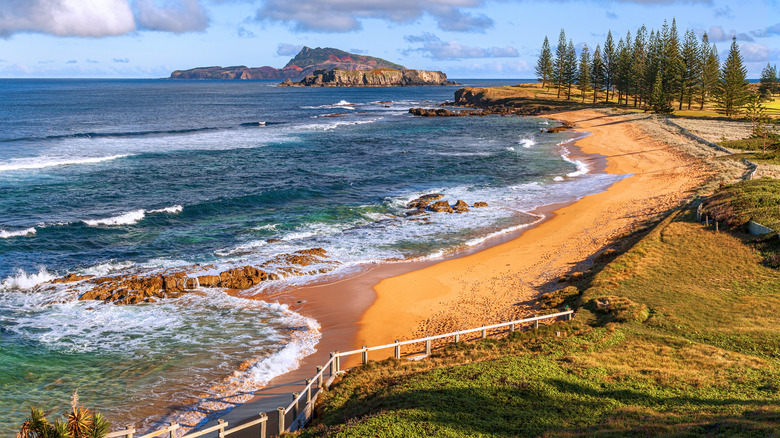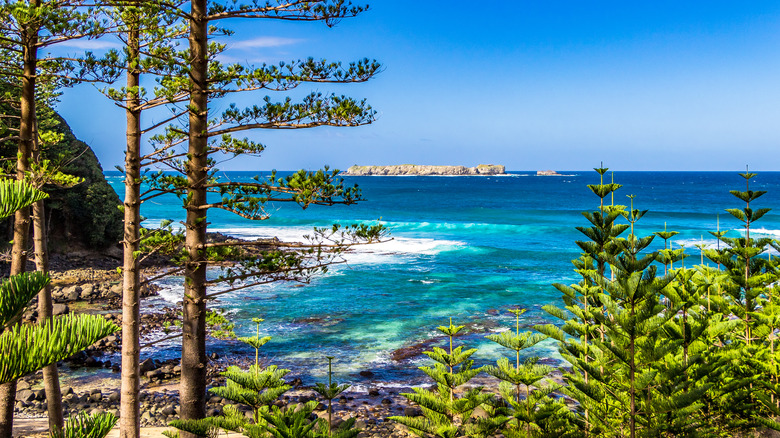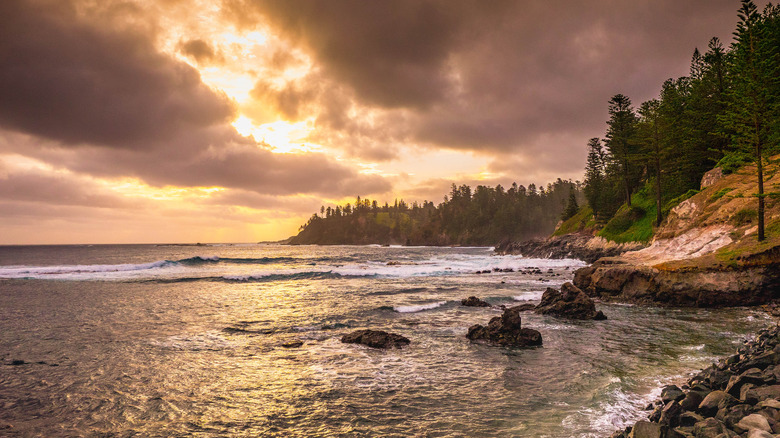Welcome to Norfolk Island — a little speck of paradise hidden in the South Pacific, considered by some to be heaven on earth. Located just a short two-and-a-half-hour flight away from Brisbane, Auckland, and Sydney, it’s a small jewel teeming with flourishing wildlife and vast golden beaches. The gorgeous coastlines, crystal clear waters, and fringed coral reefs are home to a variety of unique aquatic life. Norfolk Island doesn’t have the same tropical vibe as Caribbean destinations or the Hawaiian Islands. Instead, dramatic cliffs, gently rolling hills, and lush forested woods are features of the terrain. The stunning topography that covers Norfolk Island is a one-of-a-kind wilderness sanctuary. The vast, wild headlands overlooking the South Pacific are overrun by sea pines and the tallest fern trees on the planet.
The island was first inhabited by Polynesian settlers, followed by British convicts and Bounty Mutineer descendants who influenced Norfolk Island’s culture. Everything, from traditional customs, food, and music, stems from the tumultuous history that pervaded early Norfolk Island. Locals still honor their ancestor’s heritage with celebrations and festivals every year. Several icons located around the island are a living testament to the region’s history, including Kingston Pier, where Norfolk’s settlers arrived. This historic spot on the water’s edge still serves as the main point of entry for harboring ships and vessels. The Kingston outpost is also considered a UNESCO World Heritage Site, preserving Norfolk’s fragile past and protecting the ancient convict ceremony that provides a glimpse into the harsh events that took place on the island.
Explore Norfolk’s treasure trove of beaches

Beauty can be found everywhere in this region, from land to sea. Tucked safely in the interior is Norfolk Island National Park which houses conservation projects, rare nesting birds, and seas of pine trees. Closer to the lofty sea cliffs, the water beckons. November through March are the best months for beach lovers hoping to experience the vast sandy stretches and stunning climate at their peak. Clear, sunny skies and warm ocean breezes permeate the coastline during the high season, creating perfect beach weather for visitors. Most of Norfolk’s best beaches can be found on the southern shore, backed by towering bluffs and lush vegetation.
It’s hard to find a better spot for beach combing and snorkeling than Emily Bay Lagoon. Sheltered by the rocky reef, the waters in this cove are shallow and gentle, making it a perfect spot for families and children. Opposite the gently lapping waves is a grove of pine trees whose trunks grow so high they almost seem to scrape the clouds. There’s a general consensus among Norfolk Islanders that Anson Bay on the south shore is undoubtedly the best spot to watch the sun sink into the Pacific. Unlike some of Norfolk Island’s other beaches that boast long golden sand banks, Anson Bay requires a bit of a trek to reach, but the gorgeous sunset views are greatly worth the journey. Nestled at the bottom of towering sea cliffs, powerful waves and strong swells make Anson Bay a particularly popular surfing point.
Southern beaches

Fondly known as Bumby by locals, Bumboras Beach is another exceptional stretch of paradise. Tucked on Norfolk’s southern shore, the beach is located just over half a mile west of Kingston. Like Anson Bay, the turquoise waters and pristine sandbanks of this premier beach require a steep trek to reach the bottom. It’s a popular spot for surfers chasing swells and the tidal rock pools are often swarmed by visitors hoping to catch a glimpse of exotic marine creatures. Situated above the rocky beach is Bumboras Reserve, a secluded stretch of woodland that houses rare, endemic species. Just five minutes away from Anson Bay, Puppy’s Point is an equally exceptional lookout point for a sunset photo sesh or picnic dinner. This breathtaking headland received its name from the dog-like rock formation tucked in the cliffs opposite the ocean.
Despite the harrowing name that might give you chills, Cemetery Beach is one of the best spots on Norfolk Island for watching the first rays of sunlight flood the island. Adjacent to the white picket fences that protect Norfolk’s historic cemetery is a long stretch of golden sand dunes that create a picture-perfect setting for sunrise watching. Less than five minutes away from Cemetery Beach, the Queen Elizabeth lookout is a local gem boasting sweeping views of the entire southern side of the island, including Phillips Island and Nepean Island. While it is close enough to reach on foot, the steep headlands mean driving might be the preferred way of reaching this coveted lookout spot.

